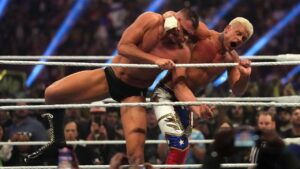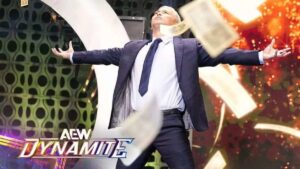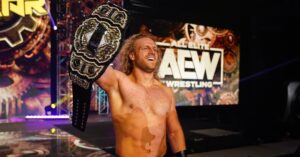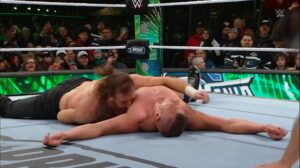He’s become infamous for being the toughest man to ever lace-up boots in the wrestling ring, more so for his legendary bar fight incidents (as recounted by countless of his peers). But Uli’uli Fifita is much more than the bruiser in these iconic stories – since 1978, he’s been a beloved (and feared) professional wrestler, better known as Haku (or his WCW moniker, Meng). He’s traveled the world to provide for his family, since leaving his home on the Isle of Tonga in 1974 at the age of 15 in search of a better life. A college rugby player, it was a chance opportunity in Japan in 1974 that propelled Haku into the world of professional wrestling and, 46 years later, in the book of wrestling’s history and mythology.
The Kingdom of Tonga is a nation of 169 islands (36 of which are inhabited) in the southern Pacific Ocean, with most of the country’s 103,000 people living on the largest island, Tongatapu. It’s 884 km (549 miles) south of its more famous cousin, Samoa, and just over 2300 km (1481 miles) east of New Zealand. It is over 10,000 km (6538 miles) to the west to the United States. In the early 1970s, Tonga was continuing to build its own legacy, on tradition and family, after the United Kingdom ended its 70-year protection status with the island nation originally signed in 1900 – although Tonga would immediately join the Commonwealth. The South Pacific islanders rely heavily on their agriculture for export – bananas, coffee/vanilla beans, coconuts, and more – but they also like to play hard. Like much of Oceania, including Australia, New Zealand, Fiji, and Samoa – rugby union football is the sport of kings. The first rugby union was started in Tonga in 1923, and since its inception in 1987, Tong has competed in every Rugby World Cup except for 1991. It was rugby that was Haku’s salvation on Tonga, competing while in college. But at the age of 15, he would be offered an opportunity to take his size and strength into a new sport all together – sumo wrestling.
Young Fifita was one of six teenagers, sent by the King of Tonga, Tāufaʻāhau Tupou IV himself, to Japan to learn the Japanese national sport of sumo wrestling – another of those teenagers on the trip was Sione Havea Vailahi, who would also end up in professional wrestling as The Barbarian. In just a year, Fafita – performing under the shikona (sumo name) of Fukunoshima – trained and competed frequently, rising to the third-highest division and ranked at Makushita 27. But despite his growing prowess, sumo would not remain in his future. The following year, the stablemaster of the heya (house or stable) that had recruited him, Asahiyama Shōgo, passed away. The new stable master, Asahiyama Tadayuki, thought much less of these foreign students and after a dispute, all six Tongans were sent home in 1976. Fafita left sumo wrestling with a 48-25-4 record. Japan wasn’t finished with Tonga Fifita just yet though. He soon found solace in the form of two former sumo wrestlers who had made the jump into professional wrestling in 1977 – Takashi Ishikawa and Genichiro Tenryu. Upon their guidance, he joined them in All Japan Pro Wrestling, where Tonga was trained by Shohei “Giant” Baba himself. Following his training – which also included learning under “High Chief” Peter Maivia – he headed to the United States to further his journey, where he began to work in territories for the National Wrestling Alliance (NWA), starting in St. Louis with famed promoter Sam Muchnik (one of the biggest names in the NWA office). Competing under the name Tonga Fifty and then Prince Tonga, he also worked in Texas and by the end of 1978, was competing regularly for Eddie Graham‘s Championship Wrestling From Florida (CWF), where he fought the likes of Killer Karl Kox, The Spoiler, and his old friend Tenryu. By the end of the year, he was competing for the NWA Florida Southern Heavyweight Championship, held by “Dirty” Dick Slater. In Tennessee, he would capture his first pro wrestling championship, the NWA World 6-Man Tag Team Championship, with Southeastern Championship Wrestling (alongside George Gulas & Ken Lucas), and in Hawaii, he would win the NWA Hawaii Heavyweight Championship with Mid-Pacific Promotions (in Hawaii, he competed under the name Tama Tonga, a name that would be passed on to one of his sons years later). He would also compete for Mid-South Wrestling and NWA Big Time Wrestling (later World Class Championship Wrestling), before returning to AJPW in 1980.
In July of 1980, as Prince Tonga, he finally made his All Japan debut during the 1980 Summer Action Series tour, defeating another gaijin in American journeyman Rick Davidson. He was pushed strong out of the gate, often competing in 6-man tag matches alongside Giant Baba and Jumbo Tsuruta, All Japan’s top stars. In Japan, Tonga competed at a new level – in the US he was used mostly on the lower card, wrestling other up-and-comers or veterans on the other side of their careers. But in Japan, he was competing against some of the best (and some future legends), including the likes of Ricky Steamboat, Billy Robinson, Harley Race, Jack Brisco, Bruiser Brody, and more. In 1981, he would enter the world of hardcore wrestling while feuding with Abdullah the Butcher. All the while, he remained entrenched in Giant Baba’s camp, continuing to tag with the All Japan founder until he left AJPW in 1984. By 1982, the Prince had been elevated, and he began calling himself King Tonga. In 1983, he added Puerto Rico to his itinerary, competing for Carlos Colon‘s Capitol Sports Promotions (later World Wrestling Council), and on January 15, 1983, in his first match in the territory, he defeated Invader #1 for the Puerto Rico Heavyweight Championship, which he held for 281-days.
King Tonga as Puerto Rico Heavyweight Champion
In the summer of 1984, King Tonga departed AJPW and headed back to North America, but instead of returning to the US territories he had traveled during his previous excursion, he headed to Canada, joining Lutte Internationale, the top promotion in Montreal, Quebec and one of Canada’s leading promotions. Lutte Internationale had begun in 1980, originally as Varoussac Promotions, founded by Andre the Giant, Frank Valois, and Gino Brito (Andre was replaced in the ownership group by Dino Bravo in 1983 when Andre signed exclusively with the WWF). King Tonga was undefeated in singles matches for his first few months, leading him to challenge Bravo for the International Heavyweight Championship, as well as face the reigning American Wrestling Association (AWA) World Heavyweight Champion and fellow International star Rick Martel. He was unsuccessful in both attempts, but King Tonga became one of the top heels in the promotion.
Following his showing against Martel, King Tonga began to work for the AWA in February of 1985, where he fought the likes of Sgt. Slaughter, Greg Gagne, Jerry Blackwell, Jim Brunzell, and more, finally getting another challenge at Martel’s AWA World title in April. Once again, he left defeated. But AWA failed to secure Tonga long term and soon King Tonga became another acquisition by Vincent Kennedy McMahon, the upstart new owner of the World Wrestling Federation (WWF) who had taken over the promotion from his father only a short few years prior in 1982. Tonga had worked a few tryout matches earlier in the year (prior to heading to AWA), defeating Cowboy “Ace” Bob Orton Jr. in his first match in January. But in August, Tonga signed with the WWF and was soon launched into a stratosphere the likes he’d never seen before. He made his WWF televised debut on WWF on NESN, a win over Rene Goulet, and followed it up a week later on WWF Championship Wrestling beating Gino Carabello (in reality, the Carabello match had been taped earlier and was Tonga’s first match as a WWF-signed wrestler). King Tonga worked his way up the card for the remainder of 1985, often teaming with Ricky Steamboat in tag matches. Despite now being a WWF wrestler, King Tonga was allowed to continue working for Lutte International due to the WWF’s working relationship with the promotion (due to this relationship, McMahon would raid more Lutte stars than just Tonga and Andre – he’d also lure over Martel, Bravo, The Rougeau Brothers (Jacques & Raymond), Tom Zenk, and more, leading the promotion to close its doors in 1987).
King Tonga would continue to feud with smaller names, but in April of 1986, he would make his WrestleMania debut at WrestleMania II in Chicago, competing in the Battle Royal that pitted WWF Superstars against NFL players. King Tonga joined the likes of Big John Studd, The Hart Foundation, Hillbilly Jim, and pro-ballers like Bill Fralic and William “The Refrigerator” Perry in the contest, which was ultimately won by Andre the Giant. Following WrestleMania II, King Tonga would begin feuding with Bobby “The Brain” Heenan and his Family, in particular, Big John Studd. In June, Tonga finally made his biggest splash in the WWF Universe up till that point, when he successfully slammed Studd in the middle of the ring – although Heenan failed to pay Tonga the $15,000 reward for doing so. But despite this gesture, King Tonga failed to move up in the card and it seemed like the WWF wasn’t quite sure what to do with the powerful Tongan.
In August of 1986, a year into being with the WWF, King Tonga was repackaged, paired with another Polynesian wrestler, the Tonga Kid, becoming a new tag team called The Islanders. Of course, Tonga Kid was not even Tongan. He was in fact Samuel Fatu, a Samoan, and part of the legendary Anoa’i family – he is the twin brother of WWE Hall of Famer Rikishi, brother of late WWE Superstar Umaga, and the uncle of The Usos. Fatu had wrestled briefly for the WWF in 1983 and 1984, famously aiding his cousin, “Superfly” Jimmy Snuka, during the latter’s famous feud with Rowdy Roddy Piper. But he disappeared soon after, before returning to the WWF in the summer of 1986. The Islanders came out of the gate as a hot new babyface tandem, utilizing a combination of high flying and power moves, facing the likes of The Dream Team (Greg “The Hammer” Valentine & Brutus Beefcake), The Hart Foundation (Bret “Hitman” Hart & Jim “The Anvil” Neidhart, and The Moondogs (Rex & Spot). By the fall, the duo had been individually renamed, with King Tonga becoming Haku and Tonga Kid renaming to Tama.
But much like his initial WWF run as King Tonga, the Islanders soon began to fizzle. Despite mild popularity and exciting matches with the upper echelon of the WWF’s tag team division, by early 1987 the duo was a fast train to nowhere – they were left off of the card for that year’s WrestleMania III in Pontiac, Michigan. Following another losing skid – against Demolition – the Islanders seemed about ready to be forgotten when Bobby Heenan entered the picture. For some time, Heenan had been talking on TV about bringing in a new tag team to the Family, and many people assumed the WWF would be debuting a new tag team from outside the company alongside the Brain. But during what was initially billed as a nice “scientific” match-up between the Islanders and the Can-Am Connection (Rick Martel & Tom Zenk) soon erupted in chaos when Heenan arrived at ringside. Initially, both teams were shocked, but while the Can-Am Connection was distracted, the Islanders attacked their opponents and beat them down, revealing themselves as Heenan’s newest acquisitions. Soon, they were winning matches against the Young Stallions (Jim Powers & Paul Roma), the British Bulldogs, the Killer Bees (B. Brian Blair & “Jumping” Jim Brunzell, and then feuding with the WWF World Tag Team Champions, Strikeforce (Rick Martel & Tito Santana). They had another big feud with the Bulldogs, highlighted by the Islanders stealing the Bulldog’s mascot, Matilda the bulldog, resulting in the Islanders & Heenan versus the Bulldogs (and Koko B. Ware) at WrestleMania IV. By 1988, the tandem was increased briefly to a trio, when they were joined by “High Chief” Afi. Afi was a Samoan wrestler trained by Peter Maivia who had worked in the Portland area for the NWA in the early 1980s as Siva Afi, before joining WWF in 1986 as a top prospect). An unfortunate illness to fellow Family member “King” Harley Race would soon reap rewards for Haku (although it meant the end of the Islanders, with Tama leaving the company that year as well).
Following a stomach injury from a match against Hulk Hogan, Heenan gave Race’s crown and robes to Haku, anointing him to be King Haku in Race’s place. Haku immediately stepped into Raace’s main event spot as well, and immediately faced Hogan, with Miss Elizabeth in Hogan’s corner. In December, he faced off against WWF World Champion “Macho Man” Randy Savage on WWF on PRISM. When Race returned at the Royal Rumble in 1989, Haku defeated him to successfully remain as WWF’s King. But like so many of Haku’s pushes in North America, it once again began to diminish, despite strong pushes out of each gate. In August of 1989, he lost his “crown” to “Hacksaw” Jim Duggan and once again he saw his position on the card begin to falter. But, still a member of Bobby Heenan’s Family, in October he was once again repackaged into a tag team, but this time it was with former WWF World Champion Andre The Giant. The duo became known as The Colossal Connection, and the duo was immediately pushed to the top of the tag team division, entering into a feud with WWF World Tag Team Champions Demolition, capturing the titles from Ax & Smash in December. It would mark the only time in his WWF career that Haku would hold championship gold.
The Colossal Connection would hold the WWF tag team titles for 109-days, defending them against the likes of the Hart Foundation, Demolition, and The Rockers (Marty Jannetty & Shawn Michaels), before losing them to Demolition at WrestleMania VI in 1990. In the loss, Heenan blamed Andre the Giant for the miscommunication that lead to the loss, effectively turning Andre babyface once again for the first time since early 1987. For the time being, it seemed that Haku was going to finally get his big push – on Saturday Night’s Main Event in late April, he became the first man to challenge The Ultimate Warrior for the WWF World Heavyweight Championship after defeating Hulk Hogan at WrestleMania.
But again, the push was short-lived and he once again became a fall guy in Heenan’s Family. While he briefly feuded with “Texas Tornado” Kerry Von Erich for the WWF Intercontinental Championship in the fall, and then a feud with the returning Davey Boy Smith (now simply The British Bulldog), he soon found himself on the losing end of most of his matches. He would also make a return to Japan in 1990, as part of the multi-promotion event Wrestling Summit – featuring WWF, AJPW, and New Japan Pro Wrestling (NJPW) – where Haku would team with his old All-Japan ally Jumbo Tsuruta to face WWF’s Mr. Perfect & Rick Martel. In early 1991, he would be reunited with one of his old sumo training partners, when The Barbarian – formerly in Powers of Pain with Warlord – and he were paired together as a new tandem in Heenan’s Family. Barbarian had split from Warlord and taken in by Heenan in the spring of 1990, but, like Haku, they were having trouble finding the right angles. The two Tongans debuted together in February of 1991 and picked up some wins over enhancement talents, and even represented the WWF in Japan with a new (but short-lived) promotion called Super World Sports (SWS). SWS had become WWF’s new ally in Japan, and while there, Haku and Barbarian also reunited in matches against the man who had helped get them into pro wrestling a decade before, Genichiro Tenryu. But with few prospects in WWF, Haku performed regularly with SWS as a WWF representative, continuing into 1992. But after appearing in the 1992 Royal Rumble, Haku had had enough and left the WWF, returning to Japan to work exclusively for SWS. Not long after joining SWS full time, he formed a new tag team with Yoshiaki Yatsu, a former All-Japan star who was a 5x tag team champion with Haku’s old friend Jumbo Tsuruta. This new team became the first-ever SWS Tag Team Champions and would become 2x tag team champions in the promotions short career. After a once-promising start and alliance with WWF, SWS would shut down its doors that June.
With SMS now closed, Haku switched promotions in Japan, joining his former mentor Tenryu in his new promotion, Wrestle Association-R (WAR). That same month, he would enter a new territory he had yet to compete in, when he headed to Mexico to begin working with Consejo Mundial de Lucha Libre (CMLL), the newly rebranded company that had emerged from Empresa Mexicana de Lucha Libre (EMLL), Mexico’s oldest and longest active company. Between WAR and CMLL, Haku was kept busy as he continued to work with many of the world’s top talents through 1994. While Haku was rebuilding his name around the world, he was also in the process of rebuilding his family. With his longtime love and wife Dorothy Koloamatangi, Haku had been blessed with two children of his own, a daughter Vika, and a son, Tevita. But in 1991, circumstances had added to the Fifita family, when Dorothy’s sister’s children, Alipate Aloisio Leone (9 years old) and Tautuiaki Taula Koloamatangi (a newborn) came to Florida to live with them, with both boys being adopted by Haku and his wife. The new extended family meant that Haku had to work harder with more mouths to provide for. In 1993, he made his official NJPW debut (outside of Wrestling Summit), when he and Barbarian took part in the G1 Climax Series tour. And in 1995, American pro wrestling came calling once again, this time from Ted Turner’s World Championship Wrestling (WCW).
The Faces of Fear remained a tag team until 1999, at which time Meng became a mainstay in WCW’s new hardcore division. He would ultimately win the WCW Hardcore Championship, his first title in WCW, in January of 2001. He would also prove to be WCW’s last Hardcore Champion, as Meng would leave WCW and return to WWF (as Haku), making a surprise return at the 2001 Royal Rumble, only one week after winning the WCW Hardcore title. He briefly teamed with Rikishi (his former Islander partner Tama’s twin brother), but the duo was short-lived, and Haku soon found himself primarily on WWF’s secondary programming, such as WWF Sunday Night Heat and WWF Jakked. By early 2002, he was only working Live Events and finally departed WWF (now WWE) in the spring of 2002.
Following his departure from WWE in 2002, Haku entered a period of semi-retirement, concentrating on his family more now that his career was winding down. He would make a one-off appearance for NJPW in May of 2004, tagging with long-time mentor Genichiro Tenryu at NJPW Nexess in Tokyo, but for much of the remainder of the 2000s, and much of the 2010s, Haku worked only a handful of appearances each year, usually in tag team action with a reunited Faces of Fear. By 2016, Haku’s family had integrated itself into the pro wrestling world, with his sons Tevita (formerly Camacho in WWE, Micah in IMPACT, and now Tanga Loa in NJPW), Alipate (Tama Tonga in NJPW), and Taula (Hikeleo in NJPW) now all members of Bullet Club, arguably the hottest New Japan faction in the world. At NJPW WrestleKingdom 10 he appeared in the New Japan Rumble and the next day at NJPW New Year Dash, he competed under the Bullet Club banner alongside Tama Tonga in a 10-man. Later that fall, he would team with both sons, Guerrillas of Destiny, in a 6-man tag match at a NJPW show in New Zealand. Since then, Haku has frequently appeared alongside his tag team champion sons, more often as a ringman, including being a part of the attack on The Elite to oust them from Bullet Club in 2018.
https://www.youtube.com/watch?v=euHTK2XXDwM
While it’s unlikely we’ll see Haku with any serious run in a major promotion now at the age of 61 years old, he still pops up from time to time in the US indies (as well as New Japan), with his latest match this past November 14, 2020 with ICW No Holds Barred, where he faced the hardcore monster known as SHLAK in a bloody affair, showing that no matter the age, Haku is still one of the game’s toughest competitors. It’s been a career that has taken him around the world in 40 years, and everywhere he’s touched, has become a part of the legend of King Haku.
SHLAK @SHLAK187 STANDING AND BANGING WITH MENG in 2020 👊#NHB8 will be available later on today on IWTV! ☠️
New to IWTV? Download the app and use the code ICWNHB for 5 days FREE! @indiewrestling @smartmarkvideo
🎥- @blklkp pic.twitter.com/EgmYd8RVE5
— ICW No Holds Barred ⛓ (@ICWNHB) November 15, 2020
Stay tuned to the Last Word on Pro Wrestling for more on this and other stories from around the world of wrestling, as they develop. You can always count on LWOPW to be on top of the major news in the wrestling world, as well as to provide you with analysis, previews, videos, interviews, and editorials on the wrestling world.
Looking to talk wrestling, pro football, or any number of sports? Head on over to the LWOS Boards to engage in conversation with fellow fans!








